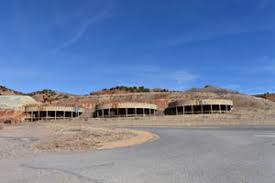I was running on empty this morning, so I sat outside drinking my morning cup of Joe and counting the rain drops. There was a frantic late night problem that raised its ugly head and I of course overdid it. But that's tomorrow's story!!
With the sprinklers STILL not working, meaning no water to the water station, I'm carrying big jugs down the hill every day to keep these thirsty guys happy. Yup, that is yet ANOTHER story!
Back to mining ... in 1885 Phelps Dodge merged the Atlanta mine with the Copper Queen (pictured here). They became the second largest producer of copper in the nation. Yeah, this doesn't look like much fun to me!! The search for gold turned into the search for silver and copper. Wouldn't you just love to go to work there every day?
The town exploded and by 1900, this is what the smelters looked like. Can you just imagine the constant noise from the mines and smelters? The surrounding hills were once covered in trees, but they quickly disappeared, being used up by the smelter. The fumes from the smelter quickly killed any plants that were left. I rather imagine it affected the humans the same.
With no regulations and no public services, you can imagine what the living conditions were like in town. Prior to 1900 there were 50 saloons and trash was just thrown in the streets, not to mention no sewer system.
With no vegetation to hold the soil on the mountains, flooding and mudslides during monsoon season were common. Here's the town trying to clean up one side of Bisbee.
By 1905, copper was big business with three big companies ... Calumet and Arizona, Shattuck-Arizona and Phelps Dodge. Lucky for the residents, Phelps Dodge moved their smelter to Douglas Arizona, cleaning up the air considerably.
With the idea of processing lower grade ore faster, Phelps Dodge began digging the Sacramento Pit in 1917. It was one of the first open pit mines and was worked until 1929, followed by the Holbrook Pit. In 1950 the Lavendar Pit was opened and is the main one you see when you drive through Bisbee.
The Lavender Pit was the last portion of the Mule Mountains to be forever scared.
This was the first one ... the Sacramento Pit. Something like 86 million tons of ore were removed from these pits.
All operations ceased in 1974, leaving an estimated 190 million tons of copper laced rock just waiting to be extracted. This is today's view of the Lavender Pit. Hey ... what's that black gooey stuff at the bottom?
They say this is acid mine drainage from sulfide minerals weathering. The water is very acidic causing iron hydroxide compounds to form, which gives it the black color. It's called AMD and is very toxic. That's Greek to me ... it looks like black tar.
Just up the hill are the remains of the smelter. I'm guessing these were separation tanks? Of course they were JUST after the copper, but any gold or silver they found was added to the money pile. They also collected Bisbee turquoise, one of the most prized kinds of turquoise in the world.
Today Bisbee is described as an Artists Community, with everything from bikers to dreadlock artists to business owners to history buffs and more. They pretty much ignore the big hole in the ground.
It's a great place to hang out for a day or two so you can check out all the cool buildings and the narrow streets. You never know who you might run into ... this used to be one of John Wayne's haunts ... and maybe still is.









I sure learned got an interesting history lesson this morning. Did even know this place existed.
ReplyDeleteFrances:)
I love all the history behind these old mining towns. It was a hard life!
DeleteMining is a necessary evil. Lithium and Cobalt Mining are needed for the "Holy Grail of Renewable Electric Energy", but the left never talks about the EVIL (pollution) created by mining the stuff. "IF" the electric vehicles really take off (forced on us) over the next 10 years, we will see new mines popping up throughout the southwest.
ReplyDeleteBut wait ... isn't that what they want to STOP? Won't that cause even MORE pollution? Someone is getting lots of money to promote that position.
DeleteVery interesting. I've got our own hole in the ground up our way in Lead!
ReplyDeleteI'm going to check that out. I guess there are mines everywhere.
Delete